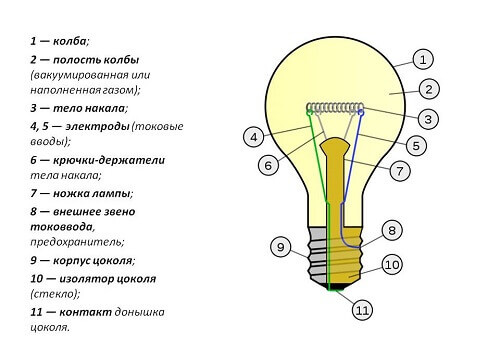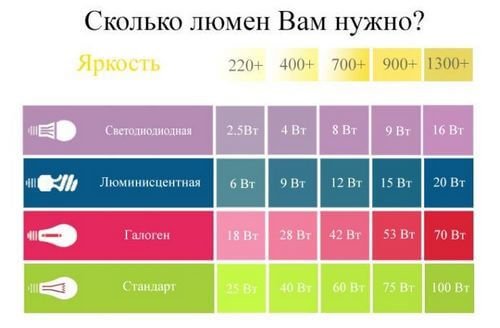Which lamps are the brightest: LED, fluorescent or halogen?
A person needs light for normal life and health. An insufficient amount of it complicates visual perception, increases fatigue. Too bright lighting dazzles, leads to overexcitation, impairs performance. Sunlight is beneficial for human health. Lightbulb companies strive to recreate the parameters of natural light in their products. New generation light bulbs are characterized by improved lighting performance and efficiency. To find out which lamps shine brighter, determine the rationality of their use, consider the most common types of light sources.
Incandescent lamp
This device, which has held the primacy for many decades, emits warm light, pleasant for visual perception.
The principle of operation of an incandescent bulb is based on heating the spiral under the influence of an electric current up to 2700 degrees, after which the tungsten, from which the filament body is made, begins to emit light photons. There is no oxygen in the flask, so the hot metal does not burn out.
The service life of an incandescent lamp averages one thousand hours, its light output is 10 Lm / W, and the color temperature is from 2800 to 3200 K.
Positive traits:
- low cost;
- variety of shapes and sizes;
- the ability to select the desired voltage rating;
- ease of installation.
Negative qualities:
- low efficiency;
- dependence of service life on power surges;
- high power consumption;
- strong heating of the flask.
Incandescent bulbs are made with a transparent or matte bulb. In order not to spoil the vision by direct contact with the eyes of the light flux, transparent sources can only be used in closed luminaires.
Halogen
The principle of operation of these devices is the same as that of incandescent lamps. The difference is that at halogen sources, halogens - bromine or iodine vapors - are mixed into an inert gas in a flask. This allows you to increase the temperature of the filament and reduce the evaporation of tungsten. At the same time, the service life of halogen lamps increases by 2-3 times, and their dimensions are reduced.
Halogen lamps are made of quartz. You need to touch such a flask with gloves, otherwise the device will quickly fail. The light output of the device is 20-30 Lm / W, the service life is from two to seven thousand hours, the color temperature is 2700 - 3200 K, and the power is from 12 W to 1000 W. The presence of reflectors allows the lamp to shine brighter. 50 Watt sources with reflectors are as bright as 150 Watt.
Positive traits:
- variety of shapes and sizes;
- large selection of power, from 12 to 1000 watts;
- the possibility of directional lighting;
- easy installation.
Negative qualities:
- sensitivity to voltage drops;
- strong heat.
Halogen lamps are used in floodlights, in fixtures built into plasterboard structures, to illuminate furniture in residential buildings or to create a "starry sky" on the ceiling.
Luminescent tubular and compact (energy-saving)
They create a comfortable diffused light, suitable for lighting large and small rooms.
 Fluorescent lamps are able to work for 10-15 thousand hours continuously. The devices have a color temperature of 4000-7000 K, a light output of 80-90 Lm / W, capable of emitting white, yellow, red, green, blue. These bright sources, often of cold light, can distort the color of surrounding objects. Tubular luminescent devices are used in offices, at enterprises, less often in apartments.
Fluorescent lamps are able to work for 10-15 thousand hours continuously. The devices have a color temperature of 4000-7000 K, a light output of 80-90 Lm / W, capable of emitting white, yellow, red, green, blue. These bright sources, often of cold light, can distort the color of surrounding objects. Tubular luminescent devices are used in offices, at enterprises, less often in apartments.
Compact fluorescent bulbs look like incandescent bulbs, begin to shine immediately after switching on, are easily mounted, give a bright light of a warmer spectrum.
Structurally, this is a tube with electrodes into which mercury vapor with an inert gas is pumped. Under the influence of an electric discharge, ultraviolet radiation is formed in mercury vapor, which is converted into visible light by means of a phosphor deposited on the walls of the tube.
Positive traits:
- economical in comparison with incandescent lamps;
- Do not heat up during operation.
Negative qualities:
- contain mercury, so special conditions are needed recycling;
- flicker, negatively affecting vision;
- distort color reproduction;
- sensitive to temperature changes;
- eventually cease to shine brightly;
- are more expensive than incandescent lamps.
Fluorescent lamps belong to the class of energy-saving. They should not be often turned on and off, otherwise they will quickly fail.
LED light sources
LED lamps can shine brighter and last longer than other lighting fixtures. Depending on the quality of the product, their life is from 20 to 100 thousand hours. Devices do not flicker and have excellent color rendition. Light output is about 120 Lm / W, color temperature 2700 - 3200K. This is another type of energy-saving lamp.
The main element of LED lamps is semiconductor LEDs mounted on a board, connected to a power device - a driver. The more LEDs, the brighter the source will shine. Since the diodes operate on direct current, a rectifier and a voltage reduction system are included in the driver device.
Positive traits:
- long service life (second only to metal halide);
- economical energy consumption;
- environmental Safety;
- compactness;
- resistance to shock and vibration;
- lack of heating during operation;
- resistance to frequent switching;
- quick turn on.
Negative qualities:
- opportunity ripple;
- high price.
A direct look at the bright working LEDs can lead to visual impairment, as when blinding an arc of a welding machine. Therefore, bulbs, in the design of which there is no diffuser, are used only for ceiling or street lighting. LEDs can be any shade of glow. This allows you to expand the scope of their use in design work.
Brightness comparison
What sources have the best energy-saving indicators, LED or fluorescent?
With the same luminous flux, LED lighting consumes less power than fluorescent ones. In addition, fluorescent energy-saving devices can not stand frequent inclusions. Their harmful effects on humans have not yet been sufficiently studied. In this regard, at present, LED bulbs that are absolutely safe for human health are gaining more and more popularity.
LEDs are the brightest light sources. For example, the luminous flux of an LED bulb of 4-8 watts corresponds to the flux of an incandescent lamp of 40 watts or 60 watts.
We will find out which devices will shine brighter, LED or halogen, from the table.
Obviously, in comparison with halogen, fluorescent and incandescent lamps, the brightest light sources are LED.
Metal Halide (MGL)
Due to the good quality of white light and high energy efficiency, this kind of gas discharge sources is becoming more and more popular.
MGL luminescence arises due to an electric arc discharge between the electrodes in a flask filled with mercury vapor and metal halides. In the process, tungsten vapors react with halogen compounds to form a gaseous composition of tungsten iodide that does not settle on the walls of the flask. When the lamp is turned off, tungsten is deposited on the electrodes.
Positive traits:
- long service life of 15,000-20000 hours;
- high energy efficiency;
- reduced power consumption;
- high-quality light close to natural;
- the possibility of obtaining the desired color gamut from 2700 to 20 000 K,
- improved color rendering;
- not dependent on environmental influences.
Negative qualities:
- fire hazard due to heating of the outer bulb to 500 ° C;
- sensitivity to voltage drops;
- sensitivity to pollution;
- a long period of inclusion, MGL begins to shine at full power after 5-10 minutes after switching;
- high cost.
Metal halide lamps are brighter than incandescent, halogen, and mercury lamps. They can generate from 65 to 115 Lm per 1 Watt. After any power interruption, the hot lamp will not turn on until it cools slightly.
Low Pressure Sodium Lamps (NLND)
These are the brightest light sources, with a light output of 200 Lm / W. The principle of the device: sodium vapor, passing an electric current through itself, begin to shine in yellow-orange. The inner flask NLND is made of borosilicate glass, which is resistant to aggressive environment.
Positive traits:
- high light output;
- long service life reaching 28,000 hours;
- the comfort of color radiation;
- wide range of operating temperatures, from - 60 to + 40 degrees Celsius;
Negative qualities:
- the presence of mercury;
- explosion hazard, fire may come into contact with air;
- inertia when turned on;
- complexity of connection and maintenance;
- low color rendering;
- increased ripple of the light flux in the network of 50 Hz;
- high ignition voltage and even higher when restarting;
- increase in power consumption during operation.
Despite the fact that low-pressure sodium lamps can shine brighter than others, and in terms of efficiency they are in the first place, they are used only in places of temporary residence of people, lighting:
- open spaces, streets, highways,
- tunnels, sports facilities, squares,
- architectural structures, airports.
Use NLND in automobile fog lights to improve visibility on roads, in warehouses and in other places where there is no need for high color rendering.
Conclusion
Having found out that of all the LEDs used for lighting homes, lamps are the brightest, it remains to determine what qualities the light emitted by them should have.
In rooms where people will constantly be, it is recommended to use sources of comfortable warm light. Cold light, perceived by a person as brighter, is appropriate in workplaces where an active attitude is important.
Warm light relaxes, cold invigorates. Each of them is appropriate in due time and in its place.
All lighting devices have both positive and negative sides. The main thing to consider when choosing them is the manufacturer's recommendations.
So we examined which lamps shine brighter. We hope the information provided was useful and interesting for you!
Related materials:















